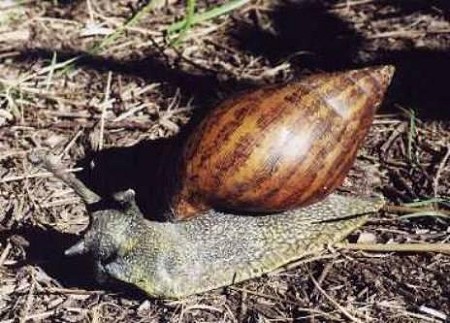An
important message from the US Department of Agriculture, Animal and Plant
Health Inspection Service
RE: Giant African Land Snails

An
important message from the US Department of Agriculture, Animal and Plant
Health Inspection Service
RE: Giant African Land Snails

To Teachers and Educators,
Giant African snails are being used increasingly in science lessons in schools. These snails are illegal in the continental United States because they are highly invasive, and can cause extensive damage to important food crops and other agricultural and natural resources. These snails can also pose a risk to human health (for information, see http://www.cdc.gov, or call your state health department). The U.S. Department of Agriculture's Animal and Plant Health Inspection Service is interested in finding these snails, and encourages those using these snails in classrooms, nature facilities or keeping them as pets to turn them in voluntarily without fear of penalty.
If you have a giant African land snail, PLEASE DO NOT RELEASE IT INTO THE ENVIRONMENT OR GIVE IT AWAY. Instead, report it to your State Department of Agriculture (you will find this office listed under State government in your phone book, or on the web at: http://www.aphis.usda.gov/npb/npbmemb.html#Members), or to the US Department of Agriculture Animal and Plant Health Inspection Service office in your state (you will find this office in your state listed under Federal or U.S. government in your phone book, or on the web at: http://www.ceris.purdue.edu/napis/names/sphdXstate.html).
"Giant African land snail" is the common name used to describe any of three snail species native to Africa and considered serious agricultural pests in the United States. The giant African snail (Achatina fulica), the giant Ghana tiger snail (Achatina achatina), and margies (Archachatina marginata) are large, terrestrial snails that reach up to 20 cm (8 inches) in length and 10 cm (4 inches) in maximum diameter. These snails are about the size of an average-size adult fist. The brownish shell with darker brown vertical stripes covers at least half the length of the snail.
Giant African snails
have a voracious appetite. They are known to eat at least 500 different types
of plants, including peanut, beans, peas, cucumbers, and melons. If fruits or
vegetables are not available, the snails will eat a wide variety of ornamental
plants, tree bark, and even paint and stucco on houses.
These snails also reproduce rapidly, laying as many as 100 to 400 eggs in a
single session. Snails contain both male and female reproductive organs, and
can lay up to 1,200 eggs per year.
There are alternative
snail species that may be used with your science curricula. Ideally, snails
that you collect locally can be used to teach about native fauna, and these
can be used without a permit. Currently the U.S. Department of Agriculture is
reviewing permit procedures for exotic mollusks for educational purposes on
a state by state basis. For more information on obtaining a permit, please visit
http://www.aphis.usda.gov/ppq/permits/plantpest/snails_slugs.html